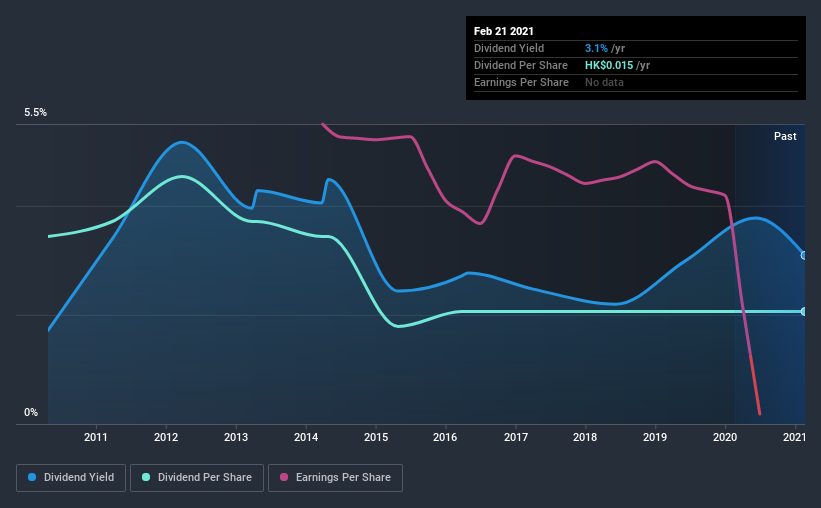Read This Before Buying Kam Hing International Holdings Limited (HKG:2307) For Its Dividend

Dividend paying stocks like Kam Hing International Holdings Limited (HKG:2307) tend to be popular with investors, and for good reason - some research suggests a significant amount of all stock market returns come from reinvested dividends. On the other hand, investors have been known to buy a stock because of its yield, and then lose money if the company's dividend doesn't live up to expectations.
In this case, Kam Hing International Holdings likely looks attractive to investors, given its 3.1% dividend yield and a payment history of over ten years. We'd guess that plenty of investors have purchased it for the income. That said, the recent jump in the share price will make Kam Hing International Holdings's dividend yield look smaller, even though the company prospects could be improving. Some simple analysis can reduce the risk of holding Kam Hing International Holdings for its dividend, and we'll focus on the most important aspects below.
Click the interactive chart for our full dividend analysis

Payout ratios
Companies (usually) pay dividends out of their earnings. If a company is paying more than it earns, the dividend might have to be cut. As a result, we should always investigate whether a company can afford its dividend, measured as a percentage of a company's net income after tax. While Kam Hing International Holdings pays a dividend, it reported a loss over the last year. When a company is loss-making, we next need to check to see if its cash flows can support the dividend.
Kam Hing International Holdings' cash payout ratio last year was 3.3%, which is quite low and suggests that the dividend was thoroughly covered by cash flow.
Consider getting our latest analysis on Kam Hing International Holdings' financial position here.
Dividend Volatility
Before buying a stock for its income, we want to see if the dividends have been stable in the past, and if the company has a track record of maintaining its dividend. Kam Hing International Holdings has been paying dividends for a long time, but for the purpose of this analysis, we only examine the past 10 years of payments. Its dividend payments have declined on at least one occasion over the past 10 years. During the past 10-year period, the first annual payment was HK$0.03 in 2011, compared to HK$0.01 last year. The dividend has shrunk at around 5.0% a year during that period. Kam Hing International Holdings' dividend has been cut sharply at least once, so it hasn't fallen by 5.0% every year, but this is a decent approximation of the long term change.
We struggle to make a case for buying Kam Hing International Holdings for its dividend, given that payments have shrunk over the past 10 years.
Dividend Growth Potential
With a relatively unstable dividend, it's even more important to evaluate if earnings per share (EPS) are growing - it's not worth taking the risk on a dividend getting cut, unless you might be rewarded with larger dividends in future. Over the past five years, it looks as though Kam Hing International Holdings' EPS have declined at around 11% a year. A sharp decline in earnings per share is not great from from a dividend perspective, as even conservative payout ratios can come under pressure if earnings fall far enough.
Conclusion
When we look at a dividend stock, we need to form a judgement on whether the dividend will grow, if the company is able to maintain it in a wide range of economic circumstances, and if the dividend payout is sustainable. We're a bit uncomfortable with the company paying a dividend while being loss-making, although at least the dividend was covered by free cash flow. Earnings per share are down, and Kam Hing International Holdings' dividend has been cut at least once in the past, which is disappointing. In summary, Kam Hing International Holdings has a number of shortcomings that we'd find it hard to get past. Things could change, but we think there are likely more attractive alternatives out there.
Investors generally tend to favour companies with a consistent, stable dividend policy as opposed to those operating an irregular one. Meanwhile, despite the importance of dividend payments, they are not the only factors our readers should know when assessing a company. Case in point: We've spotted 5 warning signs for Kam Hing International Holdings (of which 1 can't be ignored!) you should know about.
We have also put together a list of global stocks with a market capitalisation above $1bn and yielding more 3%.
If you decide to trade Kam Hing International Holdings, use the lowest-cost* platform that is rated #1 Overall by Barron’s, Interactive Brokers. Trade stocks, options, futures, forex, bonds and funds on 135 markets, all from a single integrated account. Promoted
Valuation is complex, but we're here to simplify it.
Discover if Kam Hing International Holdings might be undervalued or overvalued with our detailed analysis, featuring fair value estimates, potential risks, dividends, insider trades, and its financial condition.
Access Free AnalysisThis article by Simply Wall St is general in nature. It does not constitute a recommendation to buy or sell any stock, and does not take account of your objectives, or your financial situation. We aim to bring you long-term focused analysis driven by fundamental data. Note that our analysis may not factor in the latest price-sensitive company announcements or qualitative material. Simply Wall St has no position in any stocks mentioned.
*Interactive Brokers Rated Lowest Cost Broker by StockBrokers.com Annual Online Review 2020
Have feedback on this article? Concerned about the content? Get in touch with us directly. Alternatively, email editorial-team (at) simplywallst.com.
About SEHK:2307
Kam Hing International Holdings
An investment holding company, engages in the production and sale of knitted fabrics and dyed yarns in Hong Kong, Mainland China, Korea, Taiwan, Singapore, the United Kingdom, the United States, Vietnam, and internationally.
Adequate balance sheet slight.
Market Insights
Community Narratives




